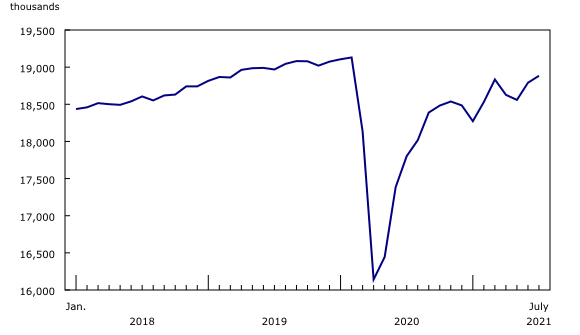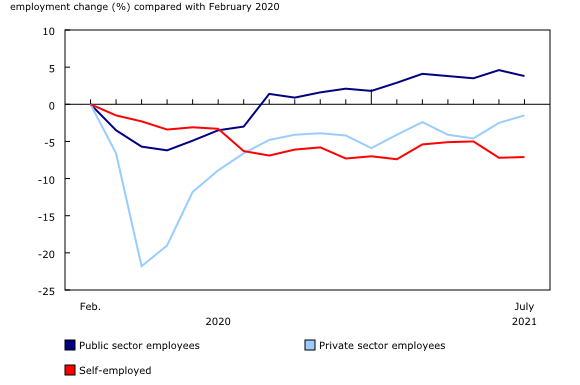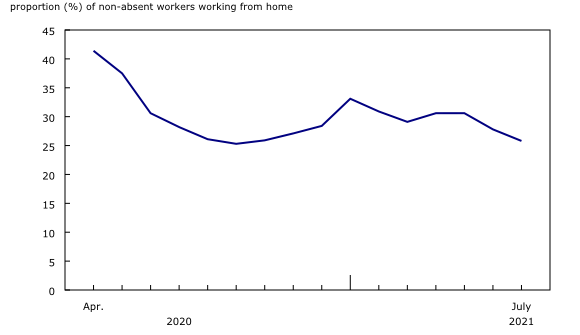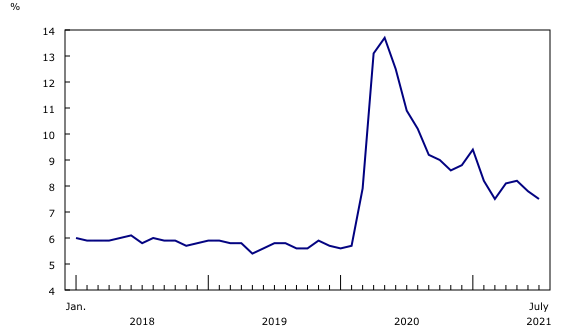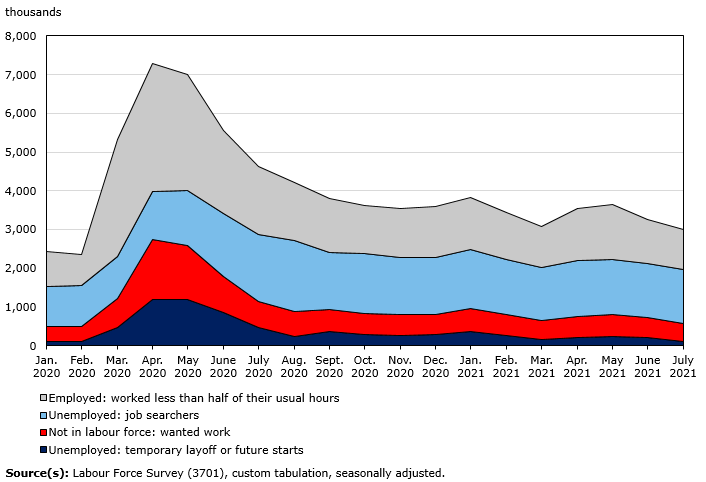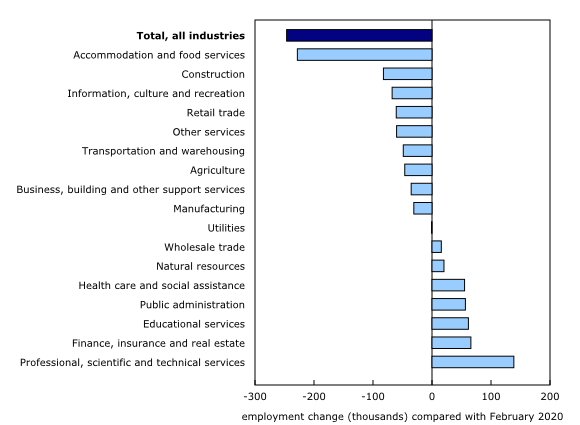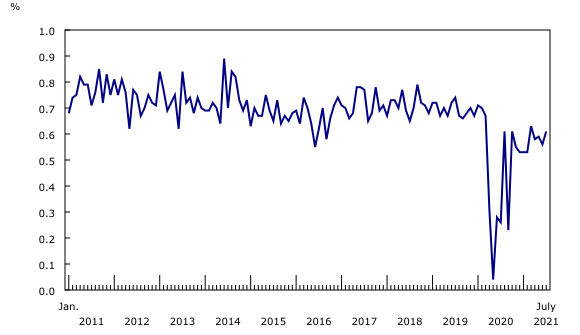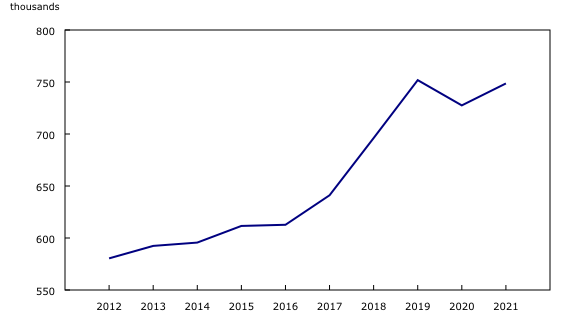Labour Force Survey, July 2021
Archived Content
Information identified as archived is provided for reference, research or recordkeeping purposes. It is not subject to the Government of Canada Web Standards and has not been altered or updated since it was archived. Please "contact us" to request a format other than those available.
Released: 2021-08-06
July Labour Force Survey (LFS) data reflect labour market conditions during the week of July 11 to 17.
Between the June and July reference weeks, many jurisdictions substantially eased public health restrictions affecting indoor and outdoor dining, recreation and cultural activities, retail shopping, and personal care services.
All public health restrictions—aside from some masking and screening requirements in select settings—were lifted in Alberta (July 1) and Saskatchewan (July 11). British Columbia also lifted virtually all restrictions (July 1), although some capacity limits on certain activities remained. All regions of Quebec moved into the lowest level of restrictions (June 28), followed by a removal of retail capacity limits (July 12).
In Ontario, personal care services partially resumed at the end of June, and the province reopened indoor dining and permitted recreational activities, with certain limitations, at the end of the LFS reference week (July 16). In Manitoba, personal care services and restaurants reopened at the end of June, and capacity limits on restaurants, gyms, and retail stores were further eased on July 17.
Highlights
Employment growth continues in July
Employment rose by 94,000 (+0.5%) in July, adding to an increase of 231,000 (+1.2%) in June.
The two consecutive months of growth brought employment to 246,000 (-1.3%) below the February 2020 level.
Youth aged 15 to 24 and core-aged women aged 25 to 54 accounted for the bulk of the gains.
All of the employment gains in July occurred in the private sector, where the number of employees rose by 123,000 (+1.0%).
July employment gains were concentrated in full-time work (+83,000; +0.5%); the first increase since March 2021.
The number of employees in the public sector fell by 31,000 (-0.7%) in July, the first decline since April 2020.
The number of employed people who worked less than half their usual hours fell by 116,000 (-10.1%).
Total hours worked were up 1.3% and were 2.7% below their pre-pandemic level.
All of the employment gains were in the services-producing sector (+93,000).
Employment increased in Ontario, Manitoba, Nova Scotia and Prince Edward Island.
Unemployment trends downward
The unemployment rate fell 0.3 percentage points to 7.5% in July, lower than the recent peak of 9.4% in January 2021.
Long-term unemployment was 244,000 higher than in February 2020 and accounted for more than one-quarter (27.8%) of total unemployment in July.
Unemployment among youth aged 15 to 24 fell by 54,000.
Among Canadians aged 55 and older, unemployment fell 22,000 (-5.9%).
Unemployment for the core-aged population aged 25 to 54 was little changed.
The labour underutilization rate declined 1.2 percentage points to 14.4%.
July employment gains concentrated in the services-producing sector
Employment rose by 35,000 in accommodation and food services.
Employment was virtually unchanged in information, culture and recreation, and in retail trade.
Following losses in May and June, the number of people who worked in goods-producing industries was little changed in July.
The number of people who worked in the manufacturing industry in Ontario increased by 26,000, which fully erased the employment losses recorded in the spring.
Employment growth continues in July
Employment rose by 94,000 (+0.5%) in July, adding to the 231,000 (+1.2%) increase in June. The unemployment rate fell 0.3 percentage points to 7.5%.
Employment growth in July was almost entirely in Ontario. Youth aged 15 to 24 and core-aged women aged 25 to 54 accounted for the bulk of gains in the month.
The two consecutive months of growth brought employment to 246,000 (-1.3%) below the February 2020 level. The employment rate was 60.3% in July, 1.5 percentage points below the pre-pandemic rate.
The number of employed people who worked less than half their usual hours fell by 116,000 (-10.1%) in July. Total hours worked were up 1.3% and were 2.7% below their pre-pandemic level.
Private sector employees drive employment growth in July while self-employment remains flat
All of the employment gains in July occurred in the private sector, where the number of employees rose by 123,000 (+1.0%), mostly in the accommodation and food services industry. This increase, combined with gains of 251,000 (+2.1%) in June, brought the number of private sector employees to within 1.5% (-191,000) of its February 2020 level.
Self-employment was little changed in July and was down 7.1% (-205,000) compared with February 2020. The number of self-employed workers has seen virtually no growth since the onset of the pandemic. The pandemic-related declines have resulted in a small shift in the distribution of the self-employed across industries. Compared with July 2019, the proportion of self-employed workers who worked in accommodation and food services was down 1.0 percentage point to 2.6% (not seasonally adjusted), while the share of those who worked in health care and social assistance increased by 1.7 percentage points to 12.5%. The professional, scientific and technical services industry continued to account for the largest share of self-employed workers (16.9%).
The number of employees in the public sector fell by 31,000 (-0.7%) in July, the first decline since April 2020. Nearly half of the monthly decrease was in Quebec (-15,000; -1.5%) and was partly due to a larger-than-usual summer decrease in the number of educational services workers. Despite this decline, public sector employment at the national level was up 150,000 (+3.8%) compared with February 2020.
July employment gains concentrated in full-time work
July employment gains were concentrated in full-time work, which rose by 83,000 (+0.5%). The increase in full-time work was the first since March 2021 and was widespread across industries.
Part-time employment held steady in July. The overall level of part-time employment was essentially the same as in February 2020, while full-time work was down 1.6% (-253,000).
Of all those who worked part-time in July, one in four (25.6%) would have preferred full-time work (30 hours or more per week). In comparison, the involuntary part-time rate averaged 30.3% in the month of July, over the period of 2010 to 2019. For workers, an inability to find full-time work may have a number of consequences, including financial pressures and delays in accumulating employment experience.
The share of Canadians working from home falls to its lowest level since October 2020
Among workers who worked at least half their usual hours, the proportion working from home fell 2.0 percentage points to 25.8% in July, returning to the pandemic lows recorded in the fall of 2020. For about half of those who worked from home (48.4%), doing so continues to represent a temporary adaptation to the pandemic. The information, culture and recreation industry saw one of the largest shifts in work location in July, with the proportion of those who worked from home falling 9.0 percentage points to 38.6%.
In addition to employment gains or losses, and changes in work location, the number of people working at different locations may be affected by absences, which are typically higher during the summer when workers are more likely to be on vacation.
Since the beginning of the COVID-19 pandemic, working from home has been a key part of public health efforts to reduce infections, with some workers being more able to take advantage of this adaptation than others. A new study, Working from home during the COVID-19 pandemic, shows that workers with a bachelor's degree or higher were much more likely to work from home during the pandemic than those without postsecondary education. This continued in July, as workers with a degree remained about three times more likely to be working from home (45.6% vs. 15.7%).
Largest employment gains among youth and core-aged women
Employment among youth aged 15 to 24 increased by 62,000 (+2.5%) in July, with gains split between young men (+36,000; +2.8%) and young women (+26,000; +2.2%). All of the gains for youth were in part-time employment (+63,000; +5.1%).
With the July gains, employment for young men returned to its February 2020 level, as a higher level of part-time work (+25,000; +4.6%) offset the decline in full-time work (-43,000;-5.5%). Among young women, part-time work was on par with pre-pandemic levels, while full-time work was down by 34,000 (-6.1%).
Employment rose 30,000 (+0.5%) for core-aged women aged 25 to 54 in July, with full-time gains (+73,000; +1.5%) more than compensating for part-time losses (-44,000; -4.2%). Overall, employment was little changed for core-aged men. Core-aged employment was 124,000 (-1.0%) below pre-COVID levels in July, with similar deficits for men (-71,000; -1.1%) and women (-53,000; -0.9%).
The employment rate for core-aged mothers whose youngest child was under 18 (74.7%) was 1.2 percentage points lower than in July 2019; whereas the rate for women in this age group without children under 18 (79.7%) was little changed from two years earlier (not seasonally adjusted). In contrast, the employment rate was closer to its pre-COVID level for core-aged fathers (91.4%; down 0.9 percentage points) than for non-fathers (82.3%; down 1.6 percentage points) (not seasonally adjusted).
Employment among women aged 55 and older fell 20,000 (-1.1%) in July, essentially wiping out June gains and leaving employment for this group 55,000 (-2.9%) below its February 2020 level. Conversely, employment among men in this age group held steady in July and has been little changed since returning to its pre-COVID level in March 2021. Compared with February 2020, the employment rate, which is a reflection of both employment and population size, was down 1.3 percentage points for men aged 55 and older in July, and by 1.7 percentage points for women of the same age group.
Teenage students see employment recovery while older students lose ground
During the summer months, the Labour Force Survey captures labour market information for youth who were full-time students in March and intended to return to school in September. This information helps to shed light on the experiences of students seeking to develop work experience and to fund their education. July is a particularly important month for student employment, as many high school students enter the labour market in June when school is over, and youth employment opportunities expand in child care and recreation activities for younger school-aged children.
In July 2021, the employment rate for returning students aged 15 to 19 was 50.6%; up 2.3 percentage points from the 2015-to-2019 July average and 8.3 percentage points higher than in July 2020. In contrast, the employment rate for returning students aged 20 to 24 (66.2%) was 4.6 percentage points lower than the historical July average, after having returned to average levels in June. LFS results for August will provide an indication of how the entire May-to-August summer job market compares with that of previous years.
Year-over-year increase in the employment rate nearly three times as large among visible minority Canadians
July 2021 marks one year since Statistics Canada first started collecting data on the labour market situation of population groups designated as visible minorities through the LFS. Year-over-year comparisons of labour market indicators provide new insights on how diverse groups of Canadians have fared since July 2020, a point in time when the unequal impacts of the pandemic first became apparent, as well as the longer-term differences in labour market circumstances between population groups.
The employment rate—the proportion of the population aged 15 and older that is employed—provides key information on the extent to which employment has recovered relative to the size of different diverse groups. From July 2020 to July 2021, employment rate increases were recorded for five of the seven largest population groups designated as visible minorities (not seasonally adjusted), led by South Asian (+11.0 percentage points to 73.5%), Black (+8.9 to 75.4%) and Latin American Canadians (+8.4 to 73.8%).
Overall, the year-over-year increase in the employment rate was nearly three times as large among visible minority Canadians (+7.3 percentage points to 70.3%, not seasonally adjusted) than among their counterparts who are not Indigenous or a visible minority (+2.6 percentage points to 70.8%).
Employment rate for very recent immigrants continues to climb
The employment rate for very recent immigrants (in Canada for five years or less) continued its upward trend in July, reaching 69.1%, or 5.3 percentage points higher than in July 2019 (three-month moving average, not seasonally adjusted). This trend has been strongly influenced by a drop in the number of newcomers to Canada since February 2020, a direct result of COVID-19 travel restrictions.
Among immigrants who have been in Canada for more than five years, the employment rate was 58.1% in July, down 2.2 percentage points compared with July 2019. For those born in Canada, the employment rate was 61.0%, down 2.5 percentage points from its pre-COVID level (three-month moving averages, not seasonally adjusted).
Employment rate for Indigenous men remains at pre-pandemic level
In July, the employment rate among Indigenous men was 60.4%, little changed from July 2019. In comparison, the rate among non-Indigenous men was 65.3%, 1.9 percentage points lower than before the pandemic. The employment rate for Indigenous women (53.6%) was 2.0 percentage points lower than its pre-pandemic level, while among non-Indigenous women, the rate (56.4%) was 2.2 percentage points lower (three-month moving averages, not seasonally adjusted).
LFS information for Indigenous people reflects the experience of those who identify as First Nations, Métis, or Inuit, and who live off reserve in the provinces.
Unemployment trends downward
The unemployment rate fell 0.3 percentage points to 7.5% in July, considerably lower than the recent peak of 9.4% in January 2021. Prior to the COVID pandemic, the unemployment rate reached a historic low of 5.4% in May 2019, and was 5.7% in February 2020.
The adjusted unemployment rate—which includes those who wanted a job but did not look for one—was 9.5% in July, down 0.6 percentage points from one month earlier.
Long-term unemployment remains elevated despite decline in July
The total number of unemployed fell by 70,000 (-4.4%) in July, including a drop of 54,000 (-11.3%) among those who had been out of work for 27 weeks or more. Long-term unemployment was 244,000 (+135.9%) higher than in February 2020 and accounted for more than one-quarter (27.8%) of total unemployment in July.
The number of people unemployed for a year or more accounted for more than two-thirds (68.8%) of the long-term unemployed, the highest proportion on record since comparable data became available in 1976.
Unemployment falls among youngest and oldest workers
Unemployment among youth aged 15 to 24 fell by 54,000 in July, with similar declines for young men (-25,000; -11.7%) and young women (-29,000; -16.5%). Among young men, the unemployment rate was down 1.8 percentage points to 12.6%, essentially returning to its February 2020 rate. The unemployment rate for young women (10.6%) was lower than the rate for young men, but was 1.6 percentage points above its pre-COVID level.
Among Canadians aged 55 and older, unemployment fell 22,000 (-5.9%) in July, with the decline occurring primarily among older women on temporary layoff. The unemployment rate for older women (7.9%) was 2.9 percentage points higher than in February 2020. The pattern was similar for men of the same age, with the unemployment rate sitting at 7.8%, 2.5 percentage points above its pre-pandemic level.
Unemployment for the core-aged population aged 25 to 54 was little changed from June. The unemployment rates for men (6.8%) and women (6.0%) in this age group were higher than in February 2020 (2.0 percentage points higher for men and 1.3 percentage points higher for women).
Unemployment rate falls among South Asian Canadians
After falling in June, the overall unemployment rate among 15- to 69-year-olds who belong to population groups designated as visible minorities held steady in July at 10.2%. A notable decline was recorded in the South Asian population (-4.1 percentage points to 8.1%, not seasonally adjusted). Nearly half of the South Asian population (44.4%) lives in the Toronto census metropolitan area (CMA), where employment increased considerably in July.
In contrast, the unemployment rate increased among Filipino (+3.1 percentage points to 10.1%) and Chinese Canadians (+1.6 percentage points to 11.8%). The unemployment rate also rose among people who were not Indigenous or a visible minority (+0.4 percentage points to 6.5%, not seasonally adjusted).
Among youth, the unemployment rate fell 1.3 percentage points to 10.9% nationally for non-visible minority Canadians (not seasonally adjusted), but was little changed for population groups designated as visible minorities overall (17.1%).
Compared with a year earlier, the unemployment rate among population groups designated as visible minorities was down 6.1 percentage points in July 2021, while it was 2.8 percentage points lower among non-visible minority Canadians (not seasonally adjusted).
Labour market underutilization at lowest level since the beginning of the pandemic
The labour underutilization rate—which complements the unemployment rate by capturing a broader range of people who are available and want to work but did not search for work, as well as those who worked less than half their usual hours—declined 1.2 percentage points to 14.4% in July. Most components of the underutilization rate dropped, led by the number of people who were employed but who worked less than half their usual hours (-116,000; -10.1%); the number of people who were on temporary layoff (-93,000; -45.3%); and the number people who were not in the labour force but wanted to work (-65,000; -12.5%).
Despite these decreases, most components of the underutilization rate remained higher than before the pandemic. Compared with February 2020, there were more people who were employed but worked less than half their usual hours (+225,000; +27.7%); more job searchers (+369,000; +35.5%); and more people who wanted a job but did not look for one (+55,000; +14.0%). In contrast, the number of people on temporary layoff was virtually the same as it was pre-pandemic for the first time since the beginning of the pandemic.
Participation in the labour force reaches pre-pandemic level for most groups
The total labour force is the sum of the employed and the unemployed. The labour force participation rate—the labour force as a proportion of the population aged 15 and older—is an indicator of the balance between the number people who are working or looking for work, and the number of people who are pursuing other activities, including studying, caring for family members and pursuing leisure or voluntary activities.
After dipping in April and May and rebounding in June, both the total labour force and the labour force participation rate held steady in July. The participation rate, at 65.2%, was 0.3 percentage points below February 2020.
Youth labour force participation was little changed in July, and the participation rates of both young women (64.5%) and young men (64.6%) were on par with pre-COVID levels.
The labour force participation rate among core-aged women rose 0.5 percentage points in July to 83.7%, while the rate was unchanged among core-aged men (91.5%). The rate for men was 0.5 percentage points higher than in February 2020, while for women it was little changed from its pre-pandemic level.
Labour force participation among those aged 55 and older fell 0.3 percentage points in July, with all of the decline occurring among older women (down 0.6 percentage points to 31.7%). While the participation rate for older men has been stable since essentially returning to its pre-pandemic level in May, the rate for older women was 0.8 percentage points lower in July than in February 2020, after having essentially returned to its pre-pandemic level in June.
July employment gains concentrated in the services-producing sector
All of the employment gains in July were in the services-producing sector (+93,000), with increases recorded in the accommodation and food services (+35,000), and finance, insurance, real estate, rental and leasing (+15,000) industries.
Following losses in May and June, the number of people who worked in goods-producing industries was little changed in July.
More people working in accommodation and food services
Employment rose by 35,000 in accommodation and food services in July, building on a notable gain of 101,000 in June. Most of the monthly increase was attributable to Ontario and Manitoba. Restaurants in Ontario began to welcome back customers for indoor dining at the end of the LFS reference week.
While there were more people working in the industry in July 2021 than in July 2020, employment in accommodation and food services was 18.7% (-228,000) below its February 2020 level in July 2021. Among industries where employment had not yet returned to pre-COVID levels, accommodation and food services accounted for over one-third (36.3%) of the overall difference between current and February 2020 employment.
Food and beverage servers working in the industry continue to be disproportionately impacted. In July 2021, employment in this occupational group was 109,000 (-37.7%) below the level recorded in July 2019, and little changed compared with July 2020 (not seasonally adjusted).
Employment rises in finance, insurance and real estate following two months of little change
In July 2021, the number of people who worked in the finance, insurance, real estate, rental and leasing industry increased for the first time since April, rising 15,000 (+1.1%).
Employment in the industry first surpassed its pre-COVID level in November 2020, and was 5.3% (+66,000) above its pre-COVID level in July 2021. Throughout the pandemic, many workers in finance, insurance, real estate, rental and leasing have adapted to public health restrictions by working from home. Among 15- to 69-year-olds who worked at least half their usual hours, the industry had the second-highest proportion of workers working from home in July (58.6%, not seasonally adjusted).
Little growth in retail trade, and information, culture and recreation
Employment was virtually unchanged in the hard-hit information, culture and recreation industry. The recovery in this industry continues to be constrained by travel restrictions and limitations on the size of public gatherings. In July, employment in the industry was 8.7% (-68,000) lower than the level recorded before the pandemic in February 2020.
The number of people who worked in retail trade was also little changed in July, and remained 2.7% (-61,000) below its pre-COVID level. While public health restrictions affecting the industry have been eased across the country, retail stores in many provinces still faced some degree of capacity limitations through late June or early July. According to the Job Vacancy and Wage Survey, total job vacancies in retail trade held steady from March to May 2021 (not seasonally adjusted).
Ontario manufacturing employment recoups spring losses
While employment was little changed in the goods-producing sector overall in July, a notable increase was recorded in Ontario (+20,000), largely as a result of gains in manufacturing.
The number of people who worked in the manufacturing industry in Ontario increased by 26,000, which fully erased employment losses recorded in the spring. This monthly gain in Ontario was offset by losses in Quebec (-11,000) and British Columbia (-11,000). Nationally, the number of people who worked in manufacturing in July was similar to its pre-COVID level.
Employment up in four provinces
Employment increased in four provinces in July, with Ontario, Manitoba, Nova Scotia and Prince Edward Island seeing gains. Saskatchewan was the only province where employment dropped. For the second consecutive month, British Columbia was the lone province with employment above its pre-pandemic level. Compared with February 2020, the employment gap was largest in Saskatchewan (-3.6%), Prince Edward Island (-3.5%), New Brunswick (-2.5%) and Newfoundland and Labrador (-2.2%).
For further information on key province and industry-level labour market indicators, see "Labour Force Survey in brief: Interactive app."
After dropping in April and May and increasing in June, employment in Ontario rose by 72,000 (+1.0%) in July, including an increase of 49,000 (+1.5%) in the Toronto census metropolitan area. While manufacturing led the provincial employment increase, accommodation and food services and wholesale and retail trade also saw gains, as the province's reopening plan allowed restaurants to resume indoor dining and retail stores to remove capacity limits. The unemployment rate fell 0.4 percentage points to 8.0%.
In Manitoba, employment increased by 7,400 (+1.1%) in July, and the unemployment rate dropped 1.5 percentage points to 6.1%. Gains were predominantly in accommodation and food services, and information, culture and recreation.
Employment in Nova Scotia increased by 3,700 (+0.8%) in July, and the unemployment rate dropped 0.6 percentage points to 8.4%. All of the gains were in full-time work and were mostly in health care and social assistance.
Prince Edward Island saw employment rise by 1,100 (+1.4%) in July, following a decline of similar magnitude the previous month. The unemployment rate fell 2.9 percentage points to 9.6%.
In Saskatchewan, employment declined (-4,500; -0.8%) for the second consecutive month, while the unemployment rate was little changed at 7.0%. Decreases in wholesale and retail trade accounted for nearly half (45.5%) of the cumulative two-month employment decline.
Labour market churn remains below pre-COVID baseline
As the easing of COVID-19 public health restrictions continues, employers face a number of challenges in resuming full business activities. At the same time, workers face their own challenges, whether they are returning to their previous industries and occupations, or entering new fields. During this period of adjustment between labour supply and demand, supplementary measures of labour market churn—the number of people changing employment status or changing jobs—are important complements to concepts such as employment, unemployment and job vacancies. For example, some aspects of churn, such as voluntary job changes, can be an indicator of whether workers feel confident in seeking new employment.
Beyond the overall net changes in the number of people who are employed, unemployed, or not in the labour force, the Labour Force Survey tracks two particular groups of workers who flow out of employment and remain jobless in the LFS reference week: those who lost a job in the past 12 months and those who left a job in the past 12 months. These indicators are part of the baseline level of churn in the labour market.
At the height of the initial COVID-19 economic shutdown, the number of core-aged people (aged 25 to 54) who lost a job due to permanent or temporary layoff in the previous 12 months was at a record high 2.0 million in April 2020. Since then, the number has gradually returned to levels consistent with the pre-pandemic baseline, and in July 2021 stood at 555,000 (not seasonally adjusted).
While the number of people who lost a job spiked as a result of COVID-19, the number of job leavers—people who left a job voluntarily in the previous 12 months and remained not employed in the LFS reference week—trended down throughout 2020 and 2021, reaching a record low of 217,000 in April 2021. Since then, the number of job leavers has increased in parallel with improving labour market conditions, but has remained substantially below pre-COVID levels. In July, there were 257,000 core-aged job leavers, down 28.3% (-101,000) compared with July 2019 (not seasonally adjusted).
In addition to flows into and out of employment, labour market churn includes workers who remain employed from one month to the next but who change jobs. The job-changing rate was 0.6% in July 2021. In other words, of people who were employed in both June and July, fewer than one in 160 (0.6%) changed jobs between the two months. After dropping to close to zero in May 2020, the job changing rate has gradually increased over the past year but has remained below the 2019 average of 0.7%.
Among employees who change jobs from one month to another, a certain proportion earn higher wages in their new job. Indeed, seeking higher income may be a key factor in the decision to change jobs. In July, 53.9% of job changers earned a higher wage in their new job, compared with an average of 49.5% in 2019 (not seasonally adjusted).
Taken together, these various indicators of churn suggest that the labour market is not yet providing the conditions necessary to fully encourage the typical level of voluntary job turnover among workers.
Wage growth strongly influenced by changes in the composition of employment
Wage growth is another important indicator of labour market conditions. Prior to the COVID-19 pandemic, year-over-year growth in average hourly wages of all employees averaged 3.5% in 2019. Since then, year-over-year wage growth has varied widely, from +10.9% in April 2020 to -1.8% in April 2021.
These large changes have been the result of several factors, including large COVID-related shifts in some of the employment characteristics most closely associated with wage levels. For example, among the five occupational groups with the lowest average hourly wages in 2019, the number of employees dropped sharply (-430,000; -14.3%) between July 2019 and July 2020 and then partially recovered (+237,000; +9.2%) by July 2021. In contrast, the number of employees in the five highest-paid occupations was little changed from July 2019 to July 2020 and increased by 116,000 (+6.4%) in the past 12 months (not seasonally adjusted).
Similarly, the large employment losses and gains resulting from COVID-19 have contributed to shifts in the balance between people who have been with their employer for a shorter time, and who are generally lower-paid, and people with more years of tenure. The proportion of employees who had been in their current job for 6 months or less was 13.2% in July 2021, up 3.6 percentage points compared with one year earlier and similar to July 2019 (13.6%) (not seasonally adjusted).
Various methods exist to provide a clearer picture of wage trends by removing the effects of changes in the composition of employment. One such method—a fixed-weighted average wage, which holds the distribution of employees across occupations and job tenures constant at the 2019 average—shows that pandemic-related changes in the distribution of employees across occupations and job tenure continue to impact indicators of wage growth.
At the onset of the initial COVID-19 economic shutdown, when there was a sudden reduction in the number of lower-wage and lower-tenure employees, average hourly wages were 10.3% (+$2.87) higher in April 2020 than the 2019 average. Using a fixed-weighted wage level to control for compositional change, this increase is reduced to less than half (+4.9%; +$1.33).
Since that time, the difference between the actual and the fixed-weighted average wage has narrowed. Nonetheless, in July 2021, the actual average hourly wage was $1.84 (+6.6%) higher than the 2019 average, whereas the fixed-weighted average wage was $1.44 (+5.2%) higher, demonstrating that accounting for changes in the composition of employment across occupation and job tenures remains important for understanding wage growth in the current context.
Looking ahead: immigration and Canada's labour market
Prior to the COVID-19 pandemic, one of the key issues facing the Canadian labour market was whether the impact of population aging, which was putting downward pressure on labour force growth, could be mitigated through increased immigration and higher participation among groups typically under-represented in the labour market.
From 2016, the number of very recent immigrants (those who arrived within the previous five years) who were participating in the labour force increased notably, and reached 752,000 in 2019. In 2020, the growth of this group stalled as a result of the number of newcomers entering Canada falling to a record low due to COVID-related travel restrictions. So far in 2021, the number of very recent immigrants participating in the labour force has returned to 2019 levels, averaging 749,000—3.7% of the total labour force—in the seven months from January to July.
As travel restrictions begin to ease, LFS results in the coming months will shed light on whether the number of new immigrants participating in Canada's labour market will continue to grow.
Sustainable Development Goals
On January 1, 2016, the world officially began implementation of the 2030 Agenda for Sustainable Development—the United Nations' transformative plan of action that addresses urgent global challenges over the next 15 years. The plan is based on 17 specific sustainable development goals.
The Labour Force Survey is an example of how Statistics Canada supports the reporting on the Global Goals for Sustainable Development. This release will be used in helping to measure the following goals:


Note to readers
The Labour Force Survey (LFS) estimates for July are for the week of July 11 to 17.
The LFS estimates are based on a sample and are therefore subject to sampling variability. As a result, monthly estimates will show more variability than trends observed over longer time periods. For more information, see "Interpreting Monthly Changes in Employment from the Labour Force Survey."
This analysis focuses on differences between estimates that are statistically significant at the 68% confidence level.
LFS estimates at the Canada level do not include the territories.
The LFS estimates are the first in a series of labour market indicators released by Statistics Canada, which includes indicators from programs such as the Survey of Employment, Payrolls and Hours (SEPH); Employment Insurance Statistics; and the Job Vacancy and Wage Survey. For more information on the conceptual differences between employment measures from the LFS and those from the SEPH, refer to section 8 of the Guide to the Labour Force Survey (71-543-G).
Since March 2020, all LFS face-to-face interviews have been replaced by telephone interviews to protect the health of both respondents and interviewers. While this has resulted in a decline in the LFS response rate, more than 40,000 interviews were completed in July and in-depth data quality evaluations conducted each month confirm that the Labour Force Survey continues to produce an accurate portrait of Canada's labour market.
The suspension of face-to-face interviewing has had a larger impact on response rates in Nunavut than in other jurisdictions. Due to the larger decline in response rates for Nunavut, and resulting changes in the composition of the responding sample, data for Nunavut (table 14-10-0292) should be used with caution. To reduce the risks associated with declining data quality for Nunavut, users are advised to use 12-month averages (available upon request) rather than 3-month averages when possible. Statistics Canada will continue to monitor the quality of LFS data for Nunavut each month and provide users with updated guidelines as required.
In addition, all telephone interviews were conducted by interviewers working from their home and none were done from Statistics Canada's call centres.
The distribution of LFS interviews in July 2021 compared with June 2021, was as follows:
Telephone interviews – from interviewer homes
• June 2021: 64.2%
• July 2021: 63.6%
Online interviews
• June 2021: 35.8%
• July 2021: 36.4%
The employment rate is the number of employed people as a percentage of the population aged 15 and older. The rate for a particular group (for example, youths aged 15 to 24) is the number employed in that group as a percentage of the population for that group.
The unemployment rate is the number of unemployed people as a percentage of the labour force (employed and unemployed).
The participation rate is the number of employed and unemployed people as a percentage of the population aged 15 and older.
Full-time employment consists of persons who usually work 30 hours or more per week at their main or only job.
Part-time employment consists of persons who usually work less than 30 hours per week at their main or only job.
The five occupation groups with the lowest average hourly wages in 2019: sales support occupations; service support and other service occupations, n.e.c.; service supervisors and specialized service occupations; labourers in processing, manufacturing and utilities; and service representatives and other customer and personal services occupations.
The five occupation groups with the highest average hourly wages in 2019: professional occupations in natural and applied sciences; occupations in front-line public protection services; middle management occupations in trades, transportation, production and utilities; specialized middle management occupations; senior management occupations.
Total hours worked refers to the number of hours actually worked at the main job by the respondent during the reference week, including paid and unpaid hours. These hours reflect temporary decreases or increases in work hours (for example, hours lost due to illness, vacation, holidays or weather; or more hours worked due to overtime).
In general, month-to-month or year-to-year changes in the number of people employed in an age group reflect the net effect of two factors: (1) the number of people who changed employment status between reference periods, and (2) the number of employed people who entered or left the age group (including through aging, death or migration) between reference periods.
Supplementary indicators used in July 2021 analysis
Employed, worked zero hours includes employees and self-employed who were absent from work all week, but excludes people who have been away for reasons such as 'vacation,' 'maternity,' 'seasonal business,' and 'labour dispute.'
Employed, worked less than half of their usual hours includes both employees and self-employed, where only employees were asked to provide a reason for the absence. This excludes reasons for absence such as 'vacation,' 'labour dispute,' 'maternity,' 'holiday,' and 'weather.' Also excludes those who were away all week.
Not in labour force but wanted work includes persons who were neither employed, nor unemployed during the reference period and wanted work, but did not search for reasons such as 'waiting for recall (to former job),' 'waiting for replies from employers,' 'believes no work available (in area, or suited to skills),' 'long-term future start,' and 'other.'
Unemployed, job searchers were without work, but had looked for work in the past four weeks ending with the reference period and were available for work.
Unemployed, temporary layoff or future starts were on temporary layoff due to business conditions, with an expectation of recall, and were available for work; or were without work, but had a job to start within four weeks from the reference period and were available for work (don't need to have looked for work during the four weeks ending with the reference week).
Labour underutilization rate (specific definition to measure the COVID-19 impact) combines all those who were unemployed with those who were not in the labour force but wanted a job and did not look for one; as well as those who remained employed but lost all or the majority of their usual work hours for reasons likely related to COVID-19 as a proportion of the potential labour force.
Potential labour force (specific definition to measure the COVID-19 impact) includes people in the labour force (all employed and unemployed people), and people not in the labour force who wanted a job but didn't search for reasons such as 'waiting for recall (to former job),' 'waiting for replies from employers,' 'believes no work available (in area, or suited to skills),' 'long-term future start,' and 'other.'
Information on population groups
Since July 2020, the LFS has included a question asking respondents to report the population group(s) to which they belong. Possible responses, which are the same as in the 2021 Census, include:
• White
• South Asian e.g., East Indian, Pakistani, Sri Lankan
• Chinese
• Black
• Filipino
• Arab
• Latin American
• Southeast Asian e.g., Vietnamese, Cambodian, Laotian, Thai
• West Asian e.g., Iranian, Afghan
• Korean
• Japanese
• Other
According to the Employment Equity Act, visible minorities are "persons, other than Aboriginal peoples, who are non-Caucasian in race or non-white in colour." In the text, people who identify as a member of a population group (visible minority) are analyzed separately.
Seasonal adjustment
Unless otherwise stated, this release presents seasonally adjusted estimates, which facilitate comparisons by removing the effects of seasonal variations. For more information on seasonal adjustment, see Seasonally adjusted data – Frequently asked questions.
The seasonally adjusted data for retail trade and wholesale trade industries presented here are not published in other public LFS tables. A seasonally adjusted series is published for the combined industry classification (wholesale and retail trade).
Next release
The next release of the LFS will be on September 10, 2021. August data will reflect labour market conditions during the week of August 15 to 21.
Products
More information about the concepts and use of the Labour Force Survey is available online in the Guide to the Labour Force Survey (71-543-G).
The product "Labour Force Survey in brief: Interactive app" (14200001) is also available. This interactive visualization application provides seasonally adjusted estimates by province, sex, age group and industry.
The product "Labour Market Indicators, by province and census metropolitan area, seasonally adjusted" (71-607-X) is also available. This interactive dashboard provides customizable access to key labour market indicators.
The product "Labour Market Indicators, by province, territory and economic region, unadjusted for seasonality" (71-607-X) is also available. This dynamic web application provides access to labour market indicators for Canada, province, territory and economic region.
The product Labour Force Survey: Public Use Microdata File (71M0001X) is also available. This public use microdata file contains non-aggregated data for a wide variety of variables collected from the Labour Force Survey. The data have been modified to ensure that no individual or business is directly or indirectly identified. This product is for users who prefer to do their own analysis by focusing on specific subgroups in the population or by cross-classifying variables that are not in our catalogued products.
Contact information
For more information, or to enquire about the concepts, methods or data quality of this release, contact us (toll-free 1-800-263-1136; 514-283-8300; STATCAN.infostats-infostats.STATCAN@canada.ca) or Media Relations (613-951-4636; STATCAN.mediahotline-ligneinfomedias.STATCAN@canada.ca).
- Date modified:




